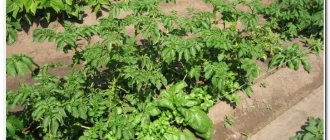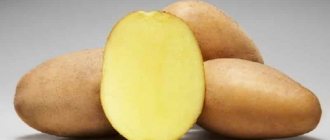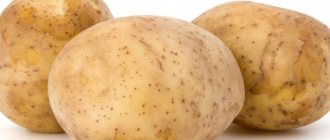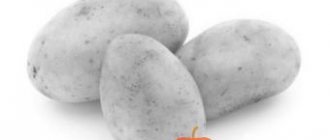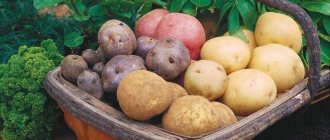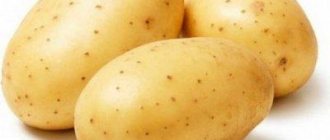The “Udacha” variety has many advantages, but the main thing that attracts gardeners is its thin peel and early ripeness. These potatoes, ripening early, produce large and tasty tubers. It is considered one of the best varieties of domestic selection. Having tried dozens of competitors, many amateur gardeners settle on “Luck”.
Breeding history
The adaptability of the variety to weather and climatic conditions allows gardeners not to depend on the vagaries of nature and consistently reap high yields.
The variety “Udacha” was developed about 30 years ago. Its authors are breeders from the State Scientific Research Institute of Potato Farming named after. A. G. Lorkha. The variety was bred on the basis of the Vilnya and Anok potatoes. During the breeding, the task was set to develop a universal variety that can grow on any soil and in any climate. The goal was achieved - “Udacha” produces high yields in the Central Black Earth Region, in the Middle Volga and Volga-Vyatka regions, in the North-West of the country and in the Far Eastern Territory.
Characteristics of the potato variety Udacha
The Udacha variety was obtained through breeding experiments with the Vilnya and Anoka varieties in Russia in 1994. A group of domestic breeders has developed a variety that is not susceptible to fungal diseases and earthen pests and, when planted annually, produces a large harvest. The nightshade crop was included in the State Register of the country only in 1998. The originator is the State Scientific Research Institute of Potato Farming named after A. G. Lorch.
It is characterized by high tops - up to 40-60 cm. The variety is bushy, with strong and flexible stems. The foliage is large, grooved, dark green matte. The front side of the sheet is soft, there are fibers. According to its characteristics, the Udacha potato is resistant to lodging and is early ripening, blooms early and fades quickly. The sepals are white, collected in small inflorescences.
After flowering, a fruit with poisonous potato seeds ripens in place of the flower. Ripe fruit is red or pink. The tuber is round or oval in shape. The color of the peel varies from light brown to yellowish cream. Luck is characterized by a thin and smooth skin with a small number of eyes. When cut, the tubers are snow-white in color, with a strong smell of starch. After heat treatment, the potatoes do not crumble and acquire a beige tint.
Description of the variety and characteristics
The variety is a table variety and is adapted to different soils. Table 1 shows the main characteristics.
Table 1
| Characteristics | |
| Maturation category | early ripening |
| Maturation period, days | 65-80 |
| Starch, % | 11-15 |
| Mass of tubers, g | 100-150 |
| Number of tubers in one bush, pieces | 10-15 |
| Productivity, c/ha | up to 430 |
| Description of tubers | round or round-oval, smooth, with small eyes, clearly visible on the light skin |
| Peel | light beige color, thin; may become richer – to light brown |
| Flesh color | white, turns yellowish when boiled |
| Keeping quality % | 88-97 |
| Attitude to diseases | susceptible to late blight, alternaria and golden potato nematode |
| Appearance of bushes | medium height, thick, height – 40 cm |
| Appearance of leaves | matte, rich green color |
| Bloom | snow-white flowers with bent petals |
| Degree of foliage | heavy foliage |
| Regions in which the variety shows the highest productivity | Central, Middle Volga, Northwestern, Volga-Vyatka, Central Black Earth, Far Eastern |
Thin and smooth peel, without unevenness, allows you to quickly and easily peel potatoes, and there is a minimum of waste.
Potatoes “Lucky”: description of the variety, photos and reviews
The “Lucky” potato is a representative of the golden fund of domestic selection.
The variety was included in the State Register in 1994, bred and patented by the All-Russian Research Institute of Potato Farming named after. A.G. Lorkha" (p/o Kraskovo, Moscow region) with the participation of 70 enterprises of the agricultural industry of Russia, who acted as originators. Among them are the Moscow Agricultural Academy named after. K. A. Timiryazeva (Moscow), North Caucasus Federal Scientific Agrarian Center (Stavropol Territory), agro (Tyumen Region), Federal State Unitary Enterprise OPH "Udarnik" (Republic of Chuvashia) and many others. The “Udacha” variety is distinguished by its ecological plasticity, is zoned for various agroclimatic conditions, is in demand by a wide range of consumers and is popular among professional vegetable growers in Russia and the countries of the former USSR. The variety is intended for personal and commercial production, recommended for cultivation in the North-Western, Central, Volga-Vyatka, Central Black Earth, North Caucasus, Middle Volga, Ural and Far Eastern regions.
Let's summarize the main characteristics of the variety in a table:
The variety is suitable for summer-autumn consumption and storage; it is one of the early varieties (the growing season from germination to technical ripeness is 65-80 days). Due to the intensive filling of tubers, commercial quality products are obtained after the 45th day.
Bushes of medium height, semi-spreading, with a voluminous above-ground part. The tops are powerful, the stems are quite resistant to lodging, and are densely covered with dark green leaves. The leaf is matte with large lobes. The inflorescences consist of several medium-sized flowers with snow-white corollas. Flower petals (sepals) are noticeably bent downwards. After abundant short flowering, berries with seeds are formed on the plants. The light sprout has a spherical shape and a red-violet color at the base.
Characteristics of tubers
Tubers of commercial quality are quite large: they gain a weight of 120-250 g; The shape is mainly oval (short) or round.
The tubers are quite smooth with a small number of small and shallow eyes, clearly visible due to their dark (brown, grayish or reddish) color. The peel is smooth, slightly mesh, thin, which ensures a small amount of waste during mechanical cleaning. The color of the peel varies from light cream or yellowish to beige. The pulp of raw tubers is white, during heat treatment it becomes slightly yellow and does not become soft. In tubers at the stage of bunch (milk) ripeness, the pulp is very tender, in mature ones it is dense, slightly mealy, and watery.
After cooking, the tubers remain intact and cut well. Potatoes "Udacha" according to their boilability characteristics are classified as type A/B.
The starch content is low - 12-14%. The variety is considered universal for culinary purposes: suitable for preparing salads, purees, boiling peeled and peeled (“in the skin”), baking, frying, stewing.
The advantages of tubers of this variety include:
- resistance to mechanical damage, such as impacts, and subsequent bluing of the pulp;
- high marketability of appearance - 85-96% of the total harvest;
- possibility of transportation and storage without loss of external and taste qualities.
The safety factor is 88-97%. The dormant period for tubers of the “Udacha” variety has an average duration: 159-197 days (from 1 to 5 points on a 9-point scale).
The duration of the dormant period of tubers depends on soil density and weather factors (amount of precipitation, air and soil temperatures at a depth of 10-15 cm) during the growing season, as well as on storage conditions (temperature and humidity). The variety is characterized by cold resistance; the tubers are ready for active germination at +10 ℃.
Productivity
The variety is distinguished by stable yield indicators: on average 420-430 c/ha.
An important thing in the description of the potato variety “Udacha” is that, according to the results of field tests, its maximum yield is 450-500 c/ha, while the marketable yield of early products after the first digging on the 45th day of the growing season reaches 180-200 c/ha. Each bush produces up to 1.5-2 kg of tubers. The yield of the variety is practically independent of soil type and is stable under unfavorable conditions (heat, drought, waterlogging).
Sustainability
Potatoes of the “Udacha” variety are quite resistant to common diseases:
The disadvantages of the variety include its susceptibility to nematodes (pale and golden cyst nematodes), fungal infections of the tops (alternaria and late blight), as well as susceptibility to pest attacks.
Features of cultivation
Since the variety has been cultivated for quite a long time, the planting material of many gardeners has a high degree of degeneration and suffers from severe contamination with viral diseases and bacterial rot. The following video will tell you about the improvement of the variety and the production of high-quality seed potatoes:
For planting potatoes, it is recommended to allocate areas where legumes or green manure previously grew, enriching the soil with nitrogen and inhibiting the growth of weeds (phacelia, lupine, mustard, spring rape, etc.).
When planting, potatoes should not be alternated with other nightshade crops (tomato, eggplant, pepper), as they are susceptible to a number of common diseases.
Seed material requires pre-warming after removal from cold storage. It is taken out in advance to a warm room or laid out for 2-3 days under sunlight. Otherwise, germination will be delayed, which will delay the formation of the harvest. Sprouted tubers begin to be planted in late April - mid-May. The main indicator for choosing the optimal planting time is the soil temperature, which should be at least 6-8 ℃.
According to reviews, “Udacha” potatoes respond well to moderate watering between rows and the application of complex (nitrogen-phosphorus-potassium) mineral or organic fertilizers.
Denis, 42 years old, Magadan
To indulge in early young potatoes of the Udacha variety, we first germinate the tubers in protected soil conditions. We plant seed potatoes in boxes filled with sawdust, water them abundantly and leave them in a warm, bright room. Formed seedlings at the age of 2 weeks are planted in open ground. To protect the soil from spring frosts, we cover the seedlings with film at first.
Read also: Apple tree Florina: description of the variety with photos, reviews
Natalya, 36 years old, Republic of Mordovia
Despite the popularity of the Udacha variety, the taste of these potatoes is mediocre. It seems that our crops have completely degenerated: the harvest is small, does not last long, and does not even last until the New Year. Next year we plan to plant the Favorit variety, which seems to be the same as Udacha, but improved.
Igor, 51 years old, Pskov
We try to update all the varieties of potatoes that we grow every 3 years. With our beloved Luck, the main difficulty now is to find high-quality planting material. If you order online, shipping costs more than the potatoes themselves! We really like the taste – white, not soggy, not soapy and not very sticky. Great for frying and other types of cooking.
The yield and presentation of tubers of the “Udacha” variety can be assessed by watching the following video:
For several years she worked as a television program editor with leading producers of ornamental plants in Ukraine. At the dacha, of all types of agricultural work, she prefers harvesting, but for this she is ready to regularly weed, pull, shed, water, tie, thin out, etc. I am convinced that the most delicious vegetables and fruits are those grown with your own hands!
Found a mistake? Select the text with the mouse and click:
You need to collect medicinal flowers and inflorescences at the very beginning of the flowering period, when the content of nutrients in them is highest. Flowers are supposed to be picked by hand, tearing off the rough stalks. Dry the collected flowers and herbs, scattered in a thin layer, in a cool room at natural temperature without access to direct sunlight.
In little Denmark, any piece of land is a very expensive pleasure. Therefore, local gardeners have adapted to growing fresh vegetables in buckets, large bags, and foam boxes filled with a special earthen mixture. Such agrotechnical methods make it possible to obtain a harvest even at home.
One of the most convenient methods for preparing a harvest of vegetables, fruits and berries is freezing. Some believe that freezing causes the nutritional and health benefits of plant foods to be lost. As a result of the research, scientists have found that there is practically no decrease in nutritional value when frozen.
Both humus and compost are rightfully the basis of organic farming. Their presence in the soil significantly increases the yield and improves the taste of vegetables and fruits. They are very similar in properties and appearance, but they should not be confused. Humus is rotted manure or bird droppings. Compost is rotted organic remains of various origins (spoiled food from the kitchen, tops, weeds, thin twigs). Humus is considered a higher quality fertilizer; compost is more accessible.
“Frost-resistant” varieties of garden strawberries (more often simply “strawberries”) need shelter just as much as ordinary varieties (especially in those regions where there are snowless winters or frosts alternating with thaws). All strawberries have superficial roots. This means that without shelter they freeze to death. Sellers’ assurances that strawberries are “frost-resistant,” “winter-hardy,” “tolerates frosts down to −35 ℃,” etc. are deception. Gardeners must remember that no one has yet managed to change the root system of strawberries.
Natural toxins are found in many plants; Those grown in gardens and vegetable gardens are no exception. Thus, the seeds of apples, apricots, and peaches contain hydrocyanic acid, and the tops and peels of unripe nightshades (potatoes, eggplants, tomatoes) contain solanine. But do not be afraid: their number is too small.
Tomatoes have no natural protection against late blight. If late blight attacks, any tomatoes (and potatoes too) die, no matter what is said in the description of the varieties (“variety resistant to late blight” is just a marketing ploy).
Compost is rotted organic remains of various origins. How to do it? They put everything in a heap, hole or large box: kitchen scraps, tops of garden crops, weeds cut before flowering, thin twigs. All this is layered with phosphate rock, sometimes straw, earth or peat. (Some summer residents add special composting accelerators.) Cover with film. During the process of overheating, the pile is periodically turned or pierced to bring in fresh air. Typically, compost “ripens” for 2 years, but with modern additives it can be ready in one summer season.
Humus is rotted manure or bird droppings. It is prepared like this: the manure is piled up in a heap or pile, layered with sawdust, peat and garden soil. The pile is covered with film to stabilize temperature and humidity (this is necessary to increase the activity of microorganisms). The fertilizer “ripens” within 2-5 years, depending on external conditions and the composition of the feedstock. The output is a loose, homogeneous mass with a pleasant smell of fresh earth.
Comparison with other varieties
To evaluate the merits of the “Udacha” variety, let’s compare it with other varieties popular in Russia. Table 2 shows a comparison of starch content. The taste of potatoes and boilability depend on this indicator.
table 2
| Variety name | Starch, % |
| Luck | 11-15 |
| Jewel | 10-15 |
| Meteor | 10-16 |
| Farmer | 9-12 |
| Timo | 13-14 |
| Arosa | 12-14 |
| Spring | 11-15 |
| Impala | 10-14 |
| Zorachka | 12-14 |
| Kamensky | 16-18 |
| Latona | 16-20 |
Table 3 shows a comparison of yields with varieties characterized by high productivity.
Table 3
| Variety name | Productivity, c/ha |
| Luck | up to 430 |
| Rowanushka | up to 400 |
| Blue | up to 500 |
| Zhuravinka | up to 640 |
| Lasunok | up to 620 |
| Sorcerer | up to 400 |
| Granada | up to 600 |
| Rogneda | up to 190-350 |
| Dolphin | up to 160-470 |
| Kiranda | up to 110-320 |
| Minerva | up to 430 |
Due to the low starch content in Udacha potatoes, diabetics can eat them without restrictions.
The bushes at “Lucky” are luxurious – spreading and dense. Flowering is short but abundant. When the flowers fade, berries with seeds form in their place. With proper agricultural technology, the average weight of tubers from one bush is 1.7 kg.
Advantages and disadvantages
It is clear that a variety that is popular with gardeners has a lot of advantages. Moreover, it has advantages over early ripening varieties. The pros and cons of the “Luck” potato are in Table 4.
Table 4
| Advantages of the variety “Lucky” | Flaws |
| Resistant to cold. Tubers germinate at +10 degrees. The plant develops normally even in cloudy and cool weather. | Affected by late blight - regular preventive treatment is required. It is also affected by Alternaria and nematodes. Due to diseases, there may be losses in the quantity and quality of tubers. |
| Fast maturation. The tubers are ready for eating already 40 days after germination - you can dig up the bushes. On the 60th day you can harvest. | |
| The tubers have a pleasant taste. The pulp is tender, well-cooked. | Poor tolerance to dense rows. |
| Resistant to scab, potato cancer, wrinkled mosaic, rhizoctonia. | |
| Well preserved. Although the variety is early, the tubers can remain safely until the next harvest without losing their presentation and pleasant taste. | If the tubers are planted in unheated soil, development is slow - ripening is delayed by 2 weeks. |
| Not picky about soil, bears fruit on sandy and dense soils. Grows on chestnut, gray forest, peat and sod-podzolic soils. Even on salt marshes it produces decent yields. | |
| Resistant to mechanical damage. Can be removed mechanically. Transports well. | |
| Great taste. The pulp holds its shape during frying and baking. |
Advantages
The advantages of the variety that distinguish it from other selection products are the following:
- Immunity to low temperatures. For active germination of tubers, an air temperature of plus 10 degrees is sufficient. Potato sprouts develop well in both cloudy and moderately cool weather. The landing date for the central regions is the end of April. Closer to the north, potatoes are planted in mid-May.
- Quick tuber setting. Approximately 1.5 months after emergence, young potatoes are quite suitable for food. The mass of tubers varies from 60 to 80 g. Young potatoes have a pleasant and delicate taste. The yield per 1 hectare after 2 months of growing season ranges from 20 to 25 tons.
- Resistance to diseases (potato cancer, rhizoctonia, mosaic, scab). Viral diseases are very rare.
- Excellent keeping quality. When ripened early, potato tubers are perfectly preserved “from harvest to harvest.” It is only important to ensure normal storage conditions. At the same time, potatoes do not lose their taste.
- Resistance to mechanical stress. The variety is very well suited for mechanical harvesting and transportation. This is especially important if potatoes are grown commercially.
- Excellent taste characteristics. The tubers are not watery and are equally suitable for mashed potatoes, baking and frying. This variety is rightfully considered one of the most delicious.
Read also: Columnar plum - varieties, description and photo, planting and care, video
Preparation for cultivation
The success of growing potatoes depends, first of all, on the competent implementation of agrotechnical measures. At every stage it is important to avoid mistakes. Growing a crop begins with preparing the soil and seed material.
Germination of tubers
Seed potatoes are selected immediately during harvesting. Take medium-sized tubers. They are stored separately from potatoes intended for food or sale.
Germination of tubers begins 2-3 weeks before planting. Potatoes that have just been taken out of a cold basement are not suitable for planting - they will take so long to germinate under a layer of soil that the harvesting date may be delayed by weeks.
Germination rules:
- Germination is carried out in the light. If the room is dark, the sprouts will turn out weak and thin.
- Seed tubers are placed in one layer - in boxes or on a spread out tarpaulin. Greening tubers has a good effect on plant development and increases resistance to bacterial infections.
- For planting, take only healthy medium-sized tubers. Sick and substandard ones are rejected. Large ones can be cut into 2 halves. It is important that there are at least 3-4 sprouts on each part of the tuber.
- Potatoes are planted when strong sprouts 1-1.5 cm long appear.
You need to cut the tubers a week before planting so that a hard crust has time to form on the cut.
The yield of the bush and the timing of ripening depend on the size of the tubers. If you use small potatoes for planting - weighing up to 30 g - then large tubers will not grow. In addition, the crop will ripen 2-3 weeks later than when planting medium-sized potatoes. The size of the tubers also affects the depth of embedding in the soil - medium ones are deepened by 8-10 cm, cut parts and small potatoes - by 5-6 cm.
Land preparation
The soil for planting potatoes begins to be prepared in the fall. It is dug up, removing perennial weeds and fertilizing it. Heavy loamy soils require more fertilizer than light, fertile soils.
Average fertilizer rate per 1 sq. m:
- manure or compost – 5-7 kg;
- superphosphate – 30-40 g;
- potassium sulfate – 15-20 g.
In the fall, you can add fresh manure to the soil, but when planting, you can’t put it in the holes, otherwise the tubers will “burn.”
In the spring, re-digging is carried out. This is especially important for heavy loamy soils - digging prevents acidification and promotes accelerated warming. Spring digging is not as deep as autumn digging. During it, 1 cup of ash and 2 tablespoons of “nitrophoska” are added to the soil for each square meter.
Landing rules
Planting is carried out in furrows or individual holes 8-10 cm deep. The distance between rows is about 30-40 cm, and between plants - 25-30 cm. You can also plant Luck potatoes in ridges.
A good result when growing potatoes of any variety requires quite careful preparation for planting. To do this, you need to take into account the timing and perform a number of pre-planting measures.
Deadlines
Luck potatoes are planted from mid-April to mid-May. More precise dates depend on the growing region and its climatic features, as well as on the weather conditions prevailing at the time of planting.
Attention!
Luck potatoes love warm soil. Its optimal temperature for this variety is 6-8 degrees Celsius. By this time the air should warm up to 12-15 degrees. In this case, the tubers will quickly sprout and the plant will grow.
Soil preparation
Despite the fact that the Udacha potato variety is not particularly capricious, some conditions must be met.
- You cannot plant potatoes in one place for more than 2 years in a row. If for some reason this has to be done, then green manure plants, most often cereal crops, are planted for the winter. Rye, wheat, oats.
- You should not choose areas where nightshade crops previously grew to grow potatoes. They share common diseases and pests.
- The best predecessors for potatoes are cabbage, melons or legumes.
Experienced vegetable growers begin preparing for planting potatoes in the fall. The area is plowed or dug up. It is not recommended to apply organic fertilizers for the winter. It is better to sow the area with winter crops.
In the spring, before planting, rotted compost is added to the soil at the rate of 2-4 buckets per square meter or 20-40 buckets per hundred square meters. It is advisable to add wood ash, as well as potassium-phosphorus fertilizers.
Tuber preparation
Medium-sized Udacha seed potato tubers are selected for planting. You should not plant very small or substandard root crops. Many people plant large potatoes after cutting them into several parts. It is important that each of them has at least 2-3 eyes. It is advisable to sprinkle the sections with wood ash or treat them with a solution of potassium manganese. This set of measures is called calibration.
To speed up the germination of potatoes and protect them from fungal diseases, the following procedures should be followed:
- Landscaping. Selected root vegetables are laid out in a sunny place for 5-7 days. When one barrel turns green, they turn them over and wait for greenery to appear on the other.
- Germination. It usually starts 2 weeks before the expected planting. Green potatoes are placed in a warm place. If possible, scatter them on burlap or tarpaulin. If not, then store them in boxes. With the appearance of the first shoots, the tubers are transferred to a cool place with little access to light. Tubers with sprouts of 3-4 cm are considered ready for planting. Longer sprouts may break off during planting.
- A small amount of seed potatoes can be soaked for 30-40 minutes in a fungicide solution. This will reduce the risk of developing late blight. Treatment is carried out the day before planting.
Each vegetable grower has his own secrets for preparing potatoes for planting, which he considers the most productive.
Landing
Luck potatoes are planted in ridges or holes. the minimum distance between holes is 40-50 cm, and between rows at least 70-80 cm. With denser planting, the yield decreases sharply. The algorithm for performing the work is as follows:
- rows are outlined;
- holes or shallow trenches are dug;
- 1-2 potatoes are placed in each hole, depending on size, in the trenches - at an equal distance from each other;
- planting holes are filled with soil.
Classic potato planting
They begin planting tubers depending on weather conditions - they are guided by the temperature of the soil. It is necessary that it warms up to +7-8°C - at a depth of 10 cm. Such conditions occur in different regions at different times:
- Northwestern region, Urals and Far East - at the end of May;
- Southern regions – mid-April.
Preparing the landing site:
- For marking you will need a cord and two bars 80-85 cm high.
- The stakes are placed at the ends of the row, with a rope tied around them until it is fully tensioned.
- A furrow is dug along the cord. Fertilizers are applied if they were not applied in the fall. It is also recommended to throw onion peels in there.
- The applied fertilizers are mixed with the soil. Tubers are placed in the furrows/holes. The distance between tubers is 20 cm.
- The distance between adjacent rows is 60 cm.
- Having planted the tubers, the area is leveled with a rake. After a week, it is recommended to go through the rake again - breaking the crust will help the seedlings break through the soil faster.
If there is a threat of frost, the beds are hilled up - more earth is piled on top. +1-2°C is enough for shoots and root sprouts to freeze.
How to plant potatoes for an early harvest?
Farmers have a way of getting early harvests. Features of the method:
- Seed tubers are placed in boxes with sawdust.
- The potatoes are watered every day.
- After 2 weeks, fully formed bushes are obtained - they can be planted in open ground.
In pursuit of early harvests, it is important not to overlook frosts. If there is a threat from them, it is better to play it safe - cover the planting with film.
The girl gardener planted the “Lucky” variety for the first time - for the sake of an early harvest. The video shows the first digging of potatoes.
Reviews
Denis, 42 years old, Sibay
To indulge in early young potatoes of the Udacha variety, we first germinate the tubers in protected soil conditions. We plant seed potatoes in boxes filled with sawdust, water them abundantly and leave them in a warm, bright room. Formed seedlings at the age of 2 weeks are planted in open ground. To protect the soil from spring frosts, we cover the seedlings with film at first.
Natalya, 36 years old, Republic of Mordovia
Despite the popularity of the Udacha variety, the taste of these potatoes is mediocre. It seems that our crops have completely degenerated: the harvest is small, does not last long, and does not even last until the New Year. Next year we plan to plant the Favorit variety, which seems to be the same as Udacha, but improved.
Igor, 51 years old, Pskov
We try to update all the varieties of potatoes that we grow every 3 years. With our beloved Luck, the main difficulty now is to find high-quality planting material. If you order online, shipping costs more than the potatoes themselves! We really like the taste – white, not soggy, not soapy and not very sticky. Great for frying and other types of cooking.
Caring for potato plantings
It is not enough to bury the tubers in the ground; you also need to take care of the conditions for their development. Caring for potatoes includes three main agrotechnical measures:
- Watering. If the summer is dry, the potato plantation will have to be watered so as not to lose the yield.
- Hilling. Several tasks are solved simultaneously - weed control, improving air exchange, protecting tubers from the sun.
- Feeding. To increase productivity, after planting, several fertilizing is carried out - with organic or mineral fertilizers, root or foliar (spraying).
Watering
The “Luck” variety does not require watering in favorable weather. But in dry summers it is better to take care of artificial soil moisture. Ideally, the water should be rain or settled tap water, and always warm. After each watering, the soil is loosened. The watering procedure is in table 5.
Table 5
| Watering no. | When to do it? |
| 1st | the first shoots appeared |
| 2nd | potato bushes bloomed |
| 3rd | two weeks before harvest |
Water must flow between the rows. It is better to water by drip rather than sprinkling.
Hilling
Lateral horizontal shoots form tubers, which must be protected from ultraviolet radiation by hilling. When the bushes grow to 10-12 cm, they are covered with soil, which is raked from the rows. Shoots 4-5 cm high should rise above the soil. Tubers will form in the ridges, and to prevent them from turning green, the soil is periodically raked - the potatoes are hilled up.
It is recommended to make furrows at the base of the bushes, thanks to which rainwater will be absorbed rather than drained.
Top dressing
There are two strategies for fertilizing - autumn-spring and during tuber development. If the soil is well fertilized in the fall and during planting, then further fertilizing is not necessary. If fertilizers are not applied in a timely manner, the plants can be fed after germination. The timing of fertilizing is in Table 6.
Table 6
| When to Apply Fertilizer | Feeding composition | How much for 1 bush |
| The first shoots appeared |
| 0.5 l |
| Flowering begins |
| |
| Flowering period |
|
With an overdose of chloride and potassium fertilizers, root vegetables with pulp prone to darkening are formed.
How to grow "Luck"
The main thing that distinguishes the “Udacha” potato from other hybrids and varieties is its unpretentiousness in terms of soil. It grows not only on chernozems, but also on clay soils, loams and sandy loam soils. But potatoes also require some care. For example, the beds need to be prepared in the fall. Potatoes grow best after melons, cabbage and cucumbers. If you plant tubers in the same place for a long time, the risk of disease increases. In addition, the variety is degenerating.
Tubers grow best in soft soil. Therefore, the area intended for planting the variety must be dug up in advance to a depth of 2 cm. At the same time, the soil is fertilized with compost or humus, based on 40 to 45 buckets per 1 hundred square meters.
For clay soils, it is most convenient to plant tubers in pre-formed ridges 15-20 cm high, with a distance between ridges of 70 cm. With such planting, the soil will warm up better. Its breathability will also increase. For chernozems, planting in “ridges” is not necessary, since the soil warms up quite well without it.
The optimal weight of a planting tuber of the “Udacha” variety is from 50 to 80 g. The variety is characterized by large potatoes, so each tuber is cut so that three or four eyes remain on each part.
For planting, you need to take only healthy potatoes. Tubers with visible signs of disease should be discarded, as there is a risk of getting infected plants.
It is recommended to treat the tubers with wood ash. The ash disinfects and plays the role of potassium fertilizer for planting material. Then the potatoes need to be placed in a single layer in a sprouting box. The optimal temperature for germination is 16-18 degrees.
The optimal time for planting the “Udacha” variety, depending on the region, is from the second half of April to mid-May. The distance between holes within a row is at least 20 cm. The interval between rows is from 30 to 40 cm. To feed the plant, you need to mix compost and wood ash in equal proportions. No more feeding is needed; it is better to feed the bushes during the first hilling.
After emergence, it is advisable to hill them up to protect them from possible night frosts. Further care of the plants consists of weeding and loosening the soil. This allows for improved air supply to the root system. It is best to loosen the soil after rain, before it has had time to dry out.
Potatoes "Luck" love nitrogen fertilizers, but they need to be fed with great care so that they do not get on the leaves and stems of the plant. In terms of watering, the variety is undemanding, so abundant watering is needed only in severe drought and hot weather.
How to protect potatoes from pests and diseases?
The “Udacha” variety has strong immunity against many potato diseases. But there are diseases and pests that he cannot cope with on his own.
Diseases and pests of the “Udacha” variety, as well as measures to combat them, are in Table 7.
Table 7
| Disease or pest | Signs | Prevention | Fighting methods |
| Late blight |
|
|
|
| Wireworm | Moves in tubers |
| Treatment of bushes with a mixture of Actellik, water and acetone - take 15 ml, 80 ml and 200 ml, respectively. |
| Stem nematode |
| Add 1 tbsp. l. wood ash into the hole - when planting. | Digging up and destroying affected plants. |
| Medvedka | Depressions in tubers |
| Treating the planting with a solution of laundry soap - take 2 bars per bucket of water. |
| Colorado beetle |
| Planting fragrant plants near potatoes:
|
|
Many gardeners fight the Colorado potato beetle using folk methods. Their main advantage is the absence of harm to humans.
Here are some options:
- Ash. 2 kg of ash is dissolved in a bucket of water and a bar of laundry soap is added.
- Sagebrush. 300 g of bitter wormwood is diluted in a bucket of hot water, and a glass of ash is added. After standing for 3 hours, spray the bushes.
- Soda and yeast. 300 g of soda and the same amount of yeast are mixed in a bucket of water. Treat bushes weekly.
- Poplar. Half a bucket of poplar leaves is poured with water and boiled for 15 minutes. After adding up to 10 liters, leave for 3 days.
- Colorado beetles. A 0.5 liter jar is filled with beetles - they must be collected by hand - and poured into a 10 liter bucket. Fill with water and close with a lid. The beetles are infused for a week and then used, diluted with water in a ratio of 1:2.
Pest and disease control
The variety copes well with pathogens of viral infections, but can be affected by nematodes, Alternaria, and late blight. Preventative measures are necessary against fungal infections and pests.
Late blight
The disease occurs during prolonged cold and high soil moisture. Signs of damage are dark spots on the tops, leaf blades, and tubers. The disease ends with rotting of the crop. For prevention, they follow the rules of crop rotation and plant green manure crops on the site.
Irrigation is carried out in several stages:
- before flowering Ridomil (dilute 25 g of powder per 10 liters);
- at the height of budding Khom (30 g of powder is dissolved in 10 liters).
Contact fungicides are also used for treatment, such as Abiga-pik, Acrobat, Zummer, Sektin, Phenomenon.
Stem nematode
If an infection has occurred, then attention is drawn to the increased bushiness of the shoots. The leaf blades are not as rich in color. Spots appear on tuber crops. Before planting, the soil is disinfected with Bazudin, and ash is added during plowing. Infected bushes are removed from the site and burned. There are effective drugs for the fight:
- Karbofos;
- Nemabact;
- Tiazon;
- Heterophos.
How to properly harvest and preserve the harvest?
To ensure that the harvest does not disappear prematurely, it must be properly harvested and stored:
- Before harvesting the tubers - 1.5-2 weeks before, the tops are cut off.
- Harvesting takes place in mid to late August, depending on planting time and climate zone. The signal for harvesting is when the bushes dry completely.
- The dug up potatoes cannot be immediately placed in the basement. First it is dried in the sun, then in the shade. Dried tubers are sorted - put aside for seeds, for food or sale, damaged potatoes are removed.
Rejected potatoes from the entire harvest are 3%, no more. Damaged tubers are stored separately from quality potatoes, and they are used for food first. Potatoes “Lucky” are stored well if the appropriate conditions are created; the optimal temperature in storage is 2-4 degrees Celsius.
Representatives of the gardening company talk about the best varieties of potatoes of domestic and Dutch selection. You can compare Dutch potatoes “Gala” with the domestic variety “Udacha”:
Growing and care
Potatoes Luck grows well in soft, loose soil. The variety is suitable for sandy soils and sandstones, loamy, transitional, and turf soil types. For fertilizing, organic compounds are recommended (solutions of mullein, manure in a dilution of 1 to 12), nitrogen agents (urea, urea) during the phase of rapid growth of stems.
When flowering begins, fertilizing with phosphorus, potassium, magnesium, and boron is used. The preparations are applied by the root method and the plantings are sprayed (Spidol Bor, Aquamix, Mag-Bor, Om, Ispolin).
Hilling is carried out when the tops are 12 cm long, and also when the bushes grow to 20 cm. The procedure is carried out after watering and fertilizing.
Reviews from farmers and ordinary gardeners
Everyone who knows a lot about potatoes and has experience in growing the “Udacha” variety is sure that this is one of the best results of domestic selection. Gardeners are attracted by the yield, unpretentiousness and taste of the tubers; farmers, in addition, are satisfied with the presentation of the potatoes they grow, their keeping quality and their ability to withstand transportation well.
★★★★★
Leonid Borisovich, 66 years old, Irkutsk region. We have been planting “Lucky” for the third year.
So far these are the best potatoes in my gardening practice. The variety has large and beautiful tubers that last well until spring, although the potatoes ripen early. Gives an excellent harvest even on peat-sandy soil. My wife also likes that the tubers are very tasty and thin-skinned - there is little waste when cleaning. ★★★★★
Elena Romanovna, 54 years old, Novosibirsk region. This potato has extremely beautiful and tasty tubers.
You can fry them or bake them in the oven, they don’t lose their shape, and they don’t get soft when cooked. And most importantly, “Udacha” ripens early - when other varieties are just setting tubers, I’m already digging up the bushes. ★★★★★
Denis Ivanov, farmer, Belgorod region. What I can say about “Udacha” is that it is an unpretentious and productive variety that stores well.
One of the disadvantages is that it can get sick if it is not treated for late blight in time. He doesn’t like thickening, so I leave 80 cm between rows instead of 60. Hide
Add your review
The “Luck” variety is chosen by gardeners and summer residents who do not have time for long fuss with garden work, and by farmers counting on an early and abundant harvest. The variety successfully combines good agrotechnical characteristics with the excellent taste of the tubers. If you want to experience the real taste of potatoes, try Luck.
0
0
Copy link
Russian potatoes of the Udacha variety: the earliest, the most delicious!
Potatoes of the Udacha variety are one of the first to appear on sale every year. Its tubers look attractive, and the thin peel allows you to prepare dishes with a minimum of waste.
This variety was obtained by Russian breeders as a result of many years of effort and it is not for nothing that it has won recognition and is popular with both farmers and consumers.
Luck is a potato that is immune to many diseases and pests. It stores well and can withstand low temperatures. And, most importantly, this is one of the most delicious varieties of potatoes. In this article you will find a description of the variety, get acquainted with its features and characteristics.
Read also: Northern captain gooseberry: description of the variety, photos, reviews
